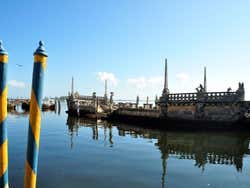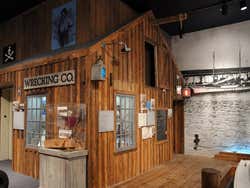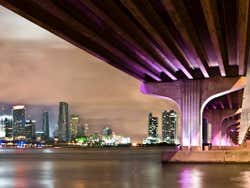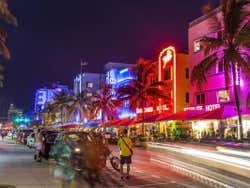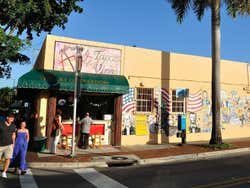
History of Miami
Discover the history of Miami, from the arrival of the Spanish in Florida, to the Seminole Wars, Cuban emigration and up to the 21st century.
The Spanish Colonisation
The first Westerners to arrive in Florida were Vicente Yánez Pinzón and Américo Vespucio who, in 1498 made it to Chesapeake lake.
Fifteen years later, on the 2nd April 1513, Juan Ponce de León arrived in Florida, which he named as such, arriving as he did on the day of "Pascua Florida" (literally Flowered Easter, referring to Easter Sunday). He had left Puerto Rico with two other boats in search of the 'fountain of youth', and made it to what is now Biscayne Bay - although it is not known if he made contact with the local population.
The area had been inhabited by native American tribes for thousands of years, among which were the 'Miami' tribe, who gave their name to the Miami river, and much later to the city itself. But the area proved difficult to conquer: Ponce de León was injured by an arrow and died a little later in Havana, and successive expeditions by Lucas Vázquez de Ayllón in 1526, Pánfilo de Narváez in 1528 and Hernando de Soto en 1539, all failed.
In 1566 another Spanish expedition left from Cadiz, under the auspices of Pedro Menéndez de Avilés, and it was he who founded the first European city in the United States - St. Augustine. He was named governor of Florida, and began to fortify the coasts, creating both the Santa Elena and Tampa forts.
The Battle for Florida
In 1562, a group of Huguenots fleeing France built "Fort Caroline" and claimed Florida for France. Their leader, Ribaut, was captured by Spanish forces and executed in his own fort.
From the late 16th century onwards there were various battles between British and Spanish forces. Francis Drake plundered and burned St. Augustine in 1586, and the borders of the Spanish territory were slowly pushed southwards, until finally, after the end of the Seven Years War, Spain ceded Florida to Great Britain.
Spain regained Florida in the 1783 Peace of Paris, which put an end to the American War of Independence. But in 1810 the newly formed United States claimed rights to Florida as part of the Louisiana Purchase, in which they took control of 828,000 square miles once owned by France. Following the Second War of Independence in 1812, Spain was obliged to sell the state the USA, an act which was made official in the Adams–Onís Treaty of 1819.
The Seminole Wars
Despite the constant fighting over Florida, where Miami stands today there were barely any westerners at the beginning of the 18th century, and the territory was occupied by the native Oconi, Mikasuki, Eufoula and Creec tribes, giving way to the Seminole people.
The First Seminole War (1817-1819) was between the Seminoles and Spanish, precipitated by the aid the native tribes gave to escaped slaves. The war ended with the sale of Florida to the United States, and the treaty put an end to the war, with the North American government promising to respect the rights of the native tribes.
The Second Semiole War (1817-1819) occurred when governor Andrew Jackson decided to renege on this pact, and began to expel the native tribes, moving them to new lands. Three thousand brave tribesmen took on 200,000 soldiers, with the tribal leader Osceola eventually being captured and his followers obliged to emigrate to Oklahoma's 'Indian lands'.
The Third Seminole War (1855-1858) was one final uprising and defeat, but finally, the vast majority of the Seminole people had to emigrate to the 'Indian Reserves', with just a handful allowed to remain in the Everglades.
Today these peoples live from agriculture, hunting and fishing, and from tourism - the Indian Reserve Casinos are well known, and have been so successful that they've enabled the purchase of the Hard Rock Café chain.
The Foundation of Miami
With the end of the Seminole war, new colonies were set up in Miami, and were supplemented with soldiers attracted by the government's offer of free land.
Some of the wealthier colonists, among the Julia Tuttle, had the idea to build a city and a hotel, and they convinced the magnate Henry Flagler to extend his rail network to Miami. The construction of the railway attracted workers to the area, and in 1896 the train to Miami was inaugurated, and plans to expand the settlement began.
On the 28th of July 1896, Miami was officially founded.
Miami in the 20th Century
During the 20s, the permissive attitudes towards gambling and the lax application of prohibition meant that thousands moved to Miami from around the US, meaning that in just three years the city doubled in size.
Real estate and financial speculation mean that land prices quadrupled in five years, making the cost of living unsustainable, that is until a major hurricane devastated the city. Miami is situated in a hurricane hotspot, and 1926 saw one of the largest in its history - that's why they say that in Miami, the great depression arrived three years early.
This great depression hit a Miami already filled with thousands of unemployed citizens. But thanks to the construction and aviation industries it rebounded quickly- and it was during this period that the Art Deco district of South Beach was constructed, with over 800 distinctive buildings.
During the Second World War, Miami was the headquarters of the U.S. army and navy, thanks to its coastal location. And with the war over, many soldiers stayed in Miami, pushing the population of the city up over half a million.
Cuban Emigration
In 1959, following the fall of the dictator Fulgencio Batista and the triumph of the Cuban Revolution, more than half a million Cubans arrived in Miami. The influx created what is known today as "Little Havana", and in 1980 there was a second wave, with 125,000 Cubans leaving the island, heading to Miami.
Over the course of decades, the flow of Cubans emigrating to Miami has been constant. And not only Cubans but people from all over Latin America have made Miami their home, transforming it into the most 'Latin' city in the USA.
Today Miami is an important financial centre (with the main headquarters of the World Bank in the USA) and a centre of entertainment (in terms of television, music, fashion and more), as well as being a crucial centre of tourism, with theme parks, beaches, and the world's most popular cruise port.

